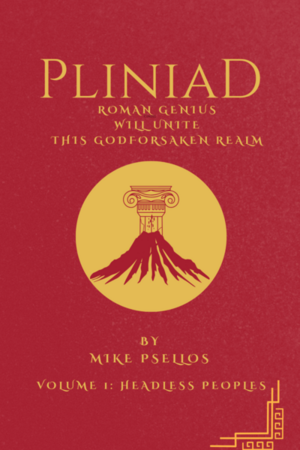Chapter 15:
Historia Naturalis: 2nd Edition: Construction of The Dioklos
Pliniad: Roman Genius Will Unite This Godforsaken Realm
Insula Sine Capito, from our estimations accrued based on the measuring of shadows and distance, a rough average distance between two spires, has approximately 16 spires across it. Each spire is roughly about five miles apart from the other. Thus, when we look at the island and see that it is narrow, we can tell that roughly 20 miles separate one edge of the island from the other. The island is oblong shaped. On the northern coast, there is nothing but empty sea. On the southern coast, below it, there seem to be islands of volcanic activity, not unlike those reported back on my own islands of Sicily, or even in Naples, as I only lately encountered in my life. To the east of the island, there seem to be several large chains of islands and other land masses that can be seen vaguely in the distance, but only on clear days.
Running from northwest to southeast along the island is a very long, single track and flat road. Some of this road seems to have been covered over by trees and shrubbery, though that can be easily rectified with the proper teams. The roadway is marked by guardrails made of metal; I would hesitate to call it steel, because it seems to be stronger than any steel I have encountered. While there is rust along parts of it, it is still amazingly sturdy, and there is no evidence that it is no longer usable. According to the Dryads, of which I am the leader, they report to me that this track, as they call it, was a rail system designed to push carts. According to their reports, the carts pushed themselves before the day the magic died, as they call it. It is this myth upon which the basis of our young Alexander Pompanianus, adopted son of Senator Pompanianus, made his daring proposal by which the Dryad tribes would leave the island through the use of a constructed ship. This ship would be placed on carts, and these carts would then carry the ship across the forest to the shore, allowing them to bypass the monsters safely inside the ship, while bringing all of their possessions without any risks of traveling through the forests unprotected.
This plan is rooted in some precedence, although this precedence to him is admittedly hearsay from me. I, myself, have seen a variant of his proposals used, but never to his level of boldness, nor impatience. A smaller, more modest version of this plan has been in use for some time in the province of Moesia, near the Roman city of Corinth. It is here in Corinth that the ancient Greeks, before our coming to this island or this peninsula, during the time of Sulla, constructed a track that went from one end of the isthmus to the other, the isthmus being the narrow strip of land that connected the mainland of Moesia to a large peninsula that we call the Peloponnesus, home to many notable people. These Greeks were famed for their skilled warriors, though most of those were absent by the time we arrived so many centuries ago. Said warriors seem to also be incapable of dealing with the issue of pirates, unlike our ancient noble Consul, Pompey Magnus, and later, great men like Julius Caesar and, of course, Vespasian Augustus, who swiftly dealt with pirates in a quick and immediate solution, of which I was happy to be a continuing part.
The same could not be said of the Greeks, and so rather than dealing with the problem through warships and patrols, they chose instead to make boats walk on land. These Corinthians would take their ships, load them, and through a crane and a mule track, carry the ship and its cargo on top of the track, which was a large, straight stone road with a groove or straight depression carved into the road. It was then that the cart would not be allowed to waver from this straight line, and so the mules were able to walk across this canal of land, carrying the ships, one at a time, from one side of the isthmus to the other, and from there the trade of Corinth prospered. These cities were able to develop.
Notably, there were attempts to bypass this project with the previous emperor, who goes by the name of Nero, a man of many ambitions and very little capacity or discipline to carry them out. At one point, he dreamed of carving a canyon into the mountainside of the isthmus, transforming the Peloponnesus into an island. Several years, much gold, and thousands of slaves later, he reached less than a third of the way through the project, and the project was abandoned on account of expense and his own choice of suicide. That is enough for the history of Corinth for now, and we will move instead to Alexander's plan.
Alexander's plan is not dissimilar to this; it will involve, however, a single, very large ship, likely being carried by multiple carts. The ship itself will be fortified with heavy logs along the front, sides, and back, thus expanding its weight, but also increasing its durability when being assaulted by the Blemmiye. I do not suspect that this will be a problem for its seaworthiness. The ship will be made sturdier and larger than the population of our tribes can carry; however, with the aid of sails, we will likely not be using galleys for some time, and with luck, we will be able to recruit new members to help us with the boat, or at the very least, reuse the wood for our first settlements when we finally move ashore and find a location.




Please sign in to leave a comment.